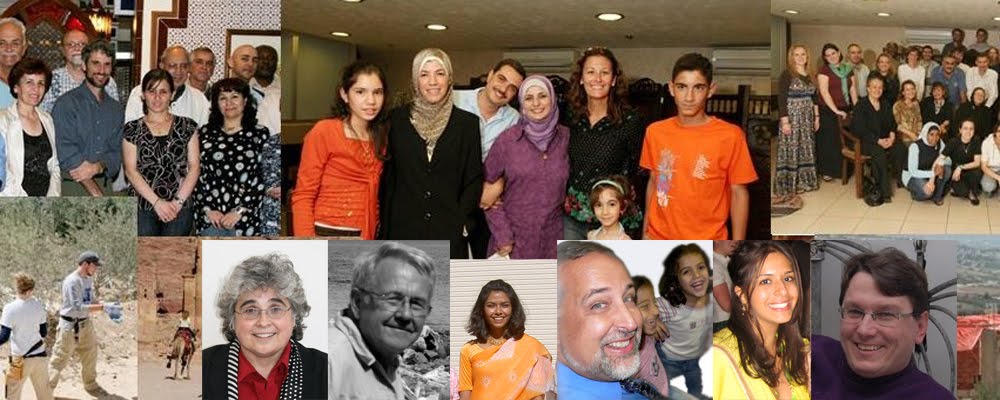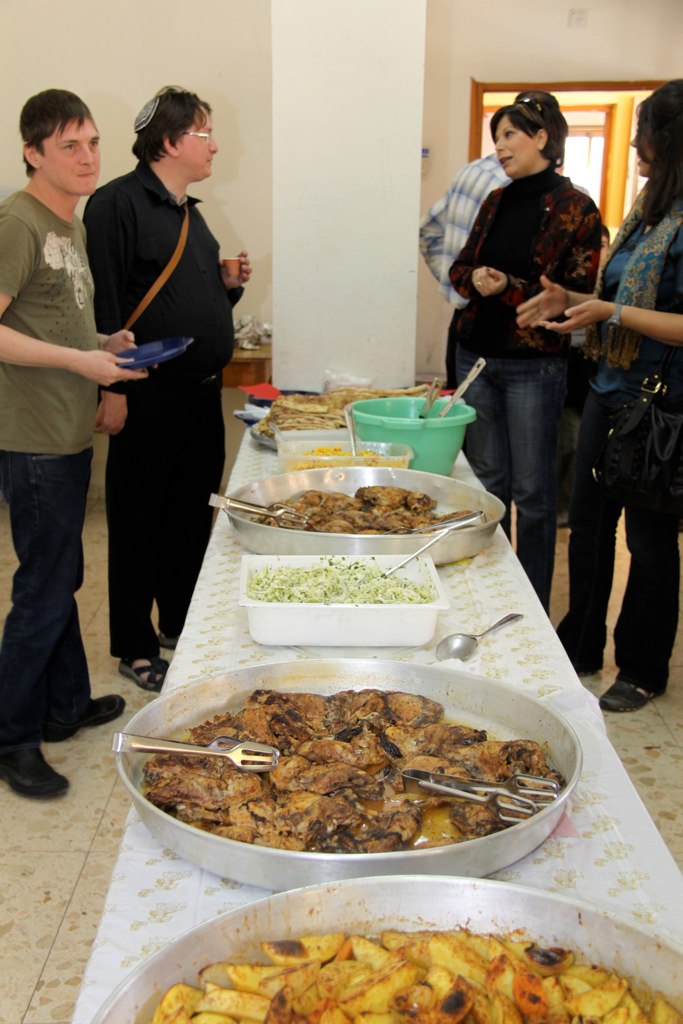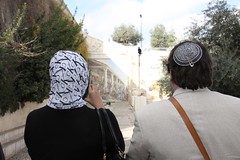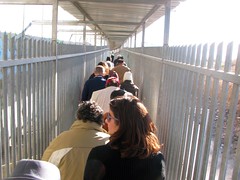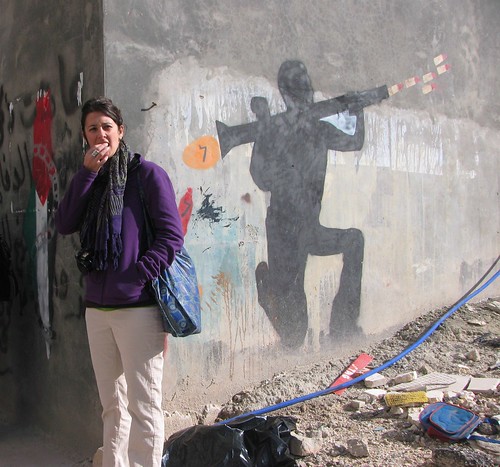The mission of International Interfaith Initiative simple yet daunting: “Foster Interfaith Cooperation and Strengthen Civil Society.” An example of how III sought to realize its mission came with the latest interfaith trip to the Middle East. III collaborated with The Village Experience on the second annual Middle East Journey, which returned to Indianapolis on January 9, 2010. Eleven individuals from Central Indiana -- representing a variety of religious, community and academic organizations -- traveled together from Amman, Jordan south through the desert sites of Petra and Wadi Rum to the Gulf of Aqaba then north through Arad, Israel, the Dead Sea, Bethlehem and several villages in the West Bank of Palestine, to Jerusalem and then to the northern Israeli towns of Haifa, Acco, Cana and Nazareth before ending the journey in Madaba, Jordan.
Charlie stands before the Dome of the Rock in Jerusalem
The two week trip included many amazing opportunities to engage local people and organizations working toward positive change in the region. Just Amman we spent an evening sharing a meal with Iraqi refugees and listening to how they are struggling to survive in Jordan; we met with Fr. Nabil Haddad, an Orthodox Priest who leads a program called “Coexistence” promoting Muslim-Christian dialogue; we listened to a lecture at Jordan University entitled “Muslims In America” that was given by IUPUI professor Edward Curtis who is there on a Fulbright Scholarship; and we visited many historic and ecologically sustainable gift shops in the city.
Participants of ME journey meet with Iraqi refugees in Amman, Jordan (Photo #1)
In the Middle East, history collides with the present in ways that are sometimes graceful, at other times quite tragic. Meeting with Iraqi refugees early on in the journey reminded me of the many mass exoduses of populations from one region to another throughout history in the Middle East. Baghdad, once the center of civilization, now has a very uncertain future as multiple forces violently struggle to gain control. The people we met, each human story that rattles the conscience, contributes to the well-worn fabric in the unfolding drama in this region.
We then traveled south through the desert to Petra and Wadi Rum, spending New Year’s Eve in a beautiful Bedouin “style” lodging that included sleeping in a tent and eating food prepared in an underground barbeque. It was a fascinating party in the middle of the Jordanian desert with an eclectic mix of culture, good music, a wonderful feast, and dancing with travelers from many countries.
Riding a camel in Wadi Rum, Jordan (Photo #2)
We crossed from Aqaba, Jordan to Elat, Israel on Friday January 1st, and were treated to a Shabbat meal at the first hotel we stayed in Arad. It felt good to participate in prayers and ritual that have been alive in that region for thousands of years. Day two took us to the Dead Sea and Bethlehem, where we stayed in a Palestinian refugee camp. We visited an under-resourced clinic meant to serve 25,000 Palestinians who are living in a “seam zone" between the 1967 border and the barrier that separates the Palestinians from Israelis.
The barrier route as of May 2005. Seam Zone, the area between the barrier and the 1949 Arab-Israeli armistice line, is colored in blue-green.
The journey then took us to Jerusalem for two days, where we visited the Old City, Yad Vashem (Holocaust Memorial), and participated in a local interfaith dialogue with the Interfaith Coordinating Council in Israel.
The conversations within our group were difficult at times as we traveled and observed challenging circumstances ... however it was enlightening to be together as a diverse group. I know for myself that my sensitivity to the narrative of the “other” was extremely heightened, and that offered me a much more in-depth experience throughout the trip. It is a unique opportunity to travel with eleven diverse individuals, each of us adding a unique piece to a puzzle as we try to better understand the world we live in. It was truly an honor to be a part of the experience, and I look forward to future conversations. It was gratifying to witness the many relationships that developed along the trip, between Muslim and Jew, Evangelical and Catholic, gay and straight, young and older. I am confident that many good things will develop as a result. Each and every one of us enriched the overall experience and I believe we all hold a piece of a puzzle that will lead to a better understanding.
Father Jeff Godecker and George Kelly praying together at the Western Wall
Our final days were spent in northern Israel and we visited the gorgeous port cities of Haifa and Acco before lodging in Nazareth for two evenings. It was dumbfounding to stand in the spot where Mary was told she’d give birth to Jesus and to then to visit the “Synagogue/Church” where Jesus proclaimed he was the Messiah.
Madonna at “Church of the Annunciation” in Nazareth
We also visited, dialogued, and shared a fantastic meal with several members of Evangelical Churches in the Galilee.
Arriving in the New York and Detroit airports after two weeks of intense and varied experiences in the Middle East and being bombarded with the latest news about the fate of Balloon Boy’s father was a bit of culture shock, to say the least- The twelve hour flight in the silver tube felt like passing through the rabbit hole and coming out on the “other” side in a completely new reality. The more I experience this, the more the saying “curiouser and curiouser” comes to mind.
International Interfaith Initiative constantly strives to find opportunities where each of us in our multiple identities can put a collective foot forward in making a better future in the Middle East, a region that is critical to a better future for all of us. It appears to make sense to work together with caring Jordanians to establish a medical clinic for Iraqi refugees who are struggling to survive in and around Amman. This effort would be more powerful if it came as a result of an interfaith effort here in Central Indiana and we will be working with many religious and community groups to make this happen. It will serve as a rich opportunity to increase understanding in our community.
When I came through customs in NYC the immigration agent asked if my visit abroad was for business or pleasure: I replied by saying a little of both, but mainly for business. He asked what type of business and I described it as an interfaith trip to better understand the issues that confront us in the Middle East. He said that it sounded like an admirable mission and wished me luck…
More about the Iraqi refugee project is at: http://www.internationalinterfaith.org/. Planning for the third Middle East Journey are underway and applications will be available on the website soon.
Article by Charlie Wiles. Photos by John Samples
